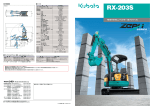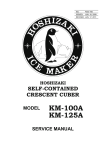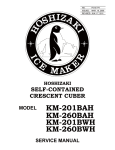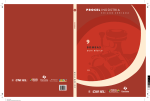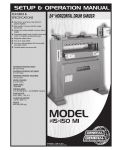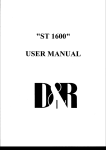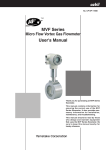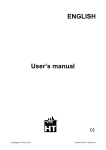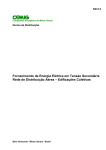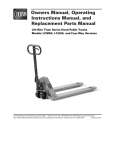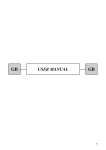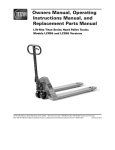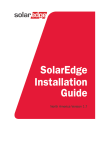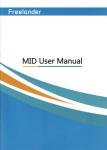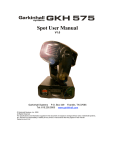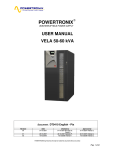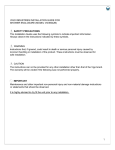Download KM50A Service Manual
Transcript
NO. 15FD-742 ISSUED: AUG. 10, 2007 REVISED: JUN. 17, 2011 HOSHIZAKI SELF-CONTAINED CRESCENT CUBER MODEL KM-30A KM-35A KM-50A KM-75A SERVICE MANUAL CONTENTS PAGE I. SPECIFICATIONS--------------------------------------------------------------------------------------1 1. DIMENSIONS/CONNECTIONS-----------------------------------------------------------------1 [a] KM-30A, KM-35A--------------------------------------------------------------------------------1 [b] KM-35A (Auxiliary code: V-1 or later, European model only)------------------------2 [c] KM-50A--------------------------------------------------------------------------------------------3 [d] KM-50A (Auxiliary code: V-1 or later, European model only)------------------------4 [e] KM-75A--------------------------------------------------------------------------------------------5 [f] KM-75A (Auxiliary code: V-1 or later, European model only)-------------------------6 2. SPECIFICATIONS-----------------------------------------------------------------------------------7 [a] KM-30A, KM-35A--------------------------------------------------------------------------------7 [b] KM-50A--------------------------------------------------------------------------------------------8 [c] KM-75A--------------------------------------------------------------------------------------------9 II. GENERAL INFORMATION------------------------------------------------------------------------ 10 1. CONSTRUCTION--------------------------------------------------------------------------------- 10 [a] KM-30A, KM-35A, KM-50A----------------------------------------------------------------- 10 [b] KM-75A------------------------------------------------------------------------------------------ 11 [c] ICEMAKING COMPARTMENT------------------------------------------------------------ 12 2. CONTROL BOARD------------------------------------------------------------------------------- 13 [a] SEQUENCE------------------------------------------------------------------------------------ 14 [b] CONTROL FEATURES---------------------------------------------------------------------- 17 [c] CONTROL BOARD LAYOUT-------------------------------------------------------------- 19 [d] CONTROLS AND ADJUSTMENTS------------------------------------------------------ 20 [e] ALARMS----------------------------------------------------------------------------------------- 23 [f] CHECKING THE CONTROL BOARD---------------------------------------------------- 24 3. SWITCHES----------------------------------------------------------------------------------------- 25 III. TECHNICAL INFORMATION--------------------------------------------------------------------- 26 1. WATER CIRCUIT AND REFRIGERANT CIRCUIT---------------------------------------- 26 [a] KM-30A, KM-35A, KM-50A----------------------------------------------------------------- 26 [b] KM-75A------------------------------------------------------------------------------------------ 27 2. WIRING DIAGRAM------------------------------------------------------------------------------- 28 3. TIMING CHART------------------------------------------------------------------------------------ 29 IV. SERVICE DIAGNOSIS----------------------------------------------------------------------------- 30 1. NO ICE PRODUCTION-------------------------------------------------------------------------- 30 2. EVAPORATOR IS FROZEN UP--------------------------------------------------------------- 32 3. LOW ICE PRODUCTION------------------------------------------------------------------------ 33 4. ABNORMAL ICE----------------------------------------------------------------------------------- 33 5. OTHERS--------------------------------------------------------------------------------------------- 34 V. REMOVAL AND REPLACEMENT--------------------------------------------------------------- 35 1. SERVICE FOR REFRIGERANT LINES----------------------------------------------------- 35 [a] SERVICE INFORMATION------------------------------------------------------------------ 35 [b] REFRIGERANT RECOVERY-------------------------------------------------------------- 36 i [c] EVACUATION AND RECHARGE--------------------------------------------------------- 36 2. BRAZING-------------------------------------------------------------------------------------------- 37 3. COMPRESSOR------------------------------------------------------------------------------------ 38 4. DRIER------------------------------------------------------------------------------------------------ 39 5. HOT GAS VALVE---------------------------------------------------------------------------------- 40 6. EXPANSION VALVE - KM-75A ONLY-------------------------------------------------------- 42 7. FAN MOTOR---------------------------------------------------------------------------------------- 44 8. PUMP MOTOR------------------------------------------------------------------------------------- 45 9. WATER VALVE------------------------------------------------------------------------------------- 46 10. DRAIN VALVE-------------------------------------------------------------------------------------- 47 11. FLOAT SWITCH----------------------------------------------------------------------------------- 48 [a] KM-30A, KM-35A, KM-50A----------------------------------------------------------------- 48 [b] KM-75A------------------------------------------------------------------------------------------ 49 12. BIN CONTROL SWITCH------------------------------------------------------------------------ 50 13. THERMISTOR------------------------------------------------------------------------------------- 53 14. CONTROL BOX----------------------------------------------------------------------------------- 54 [a] POWER SWITCH----------------------------------------------------------------------------- 55 [b] FUSE--------------------------------------------------------------------------------------------- 55 [c] FUSE HOLDER-------------------------------------------------------------------------------- 55 [d] CONTROL BOARD--------------------------------------------------------------------------- 55 [e] POWER RELAY------------------------------------------------------------------------------- 55 [f] COMPRESSOR CAPACITOR - KM-50A, KM-75A ONLY--------------------------- 56 [g] CONTROL BOARD TRANSFORMER--------------------------------------------------- 56 15. WATER TANK-------------------------------------------------------------------------------------- 56 16. CUBE GUIDE-------------------------------------------------------------------------------------- 58 17. SEPARATOR--------------------------------------------------------------------------------------- 59 18. SPRAY TUBE, WATER SUPPLY PIPE, SPRAY GUIDE-------------------------------- 59 19. DOOR------------------------------------------------------------------------------------------------ 60 VI. CLEANING AND MAINTENANCE INSTRUCTIONS--------------------------------------- 61 1. CLEANING------------------------------------------------------------------------------------------ 61 [a] CLEANING PROCEDURE------------------------------------------------------------------ 61 [b] SANITIZING PROCEDURE---------------------------------------------------------------- 63 2. MAINTENANCE----------------------------------------------------------------------------------- 64 [a] EXTERIOR PANELS------------------------------------------------------------------------- 64 [b] STORAGE BIN AND SCOOP-------------------------------------------------------------- 64 [c] AIR FILTER------------------------------------------------------------------------------------- 64 [d] CONDENSER---------------------------------------------------------------------------------- 64 3. PREPARING THE ICEMAKER FOR LONG STORAGE--------------------------------- 64 ii I. SPECIFICATIONS 1. DIMENSIONS/CONNECTIONS [a] KM-30A, KM-35A Unit: mm 1 [b] KM-35A (Auxiliary code: V-1 or later, European model only) Unit: mm 2 [c] KM-50A Unit: mm 3 [d] KM-50A (Auxiliary code: V-1 or later, European model only) Unit: mm 4 [e] KM-75A Unit: mm 5 [f] KM-75A (Auxiliary code: V-1 or later, European model only) Unit: mm 6 2. SPECIFICATIONS [a] KM-30A, KM-35A AC SUPPLY VOLTAGE AMPERAGE STARTING AMPERAGE ELECTRIC CONSUMPTION POWER FACTOR POWER SUPPLY CAPACITY ICE PRODUCTION PER 24h WATER CONSUMPTION PER 24h 1 PHASE 220-240V 50Hz 1.5A (AT.32°C, WT.21°C) 10.0A 195W (AT.32°C, WT.21°C) 54% Min.0.65KVA (2.73A) Approx. 36kg (AT.10°C,WT.10°C) Approx. 32kg (AT.21°C,WT.15°C) Approx. 25kg (AT.32°C,WT.21°C) Approx. 0.142m3 (AT.10°C, WT.10°C) Approx. 0.060m3 (AT.21°C, WT.15°C) Approx. 0.042m3 (AT.32°C, WT.21°C) CRESCENT CUBE Approx. 30min (AT.21°C, WT.15°C) Approx. 0.71kg / 80pcs (AT.21°C, WT.15°C) Approx. 16kg (Bin Control Setting Approx.14kg) 450㎜(W)×610㎜(D)×842㎜(H) (D03921) Stainless Steel, Galvanized Steel (Rear) Polyurethane Foam Y-type Con. (with CONT. Plug) X-type Con. (With Plug) Inlet G3/4 (connected at rear side) Outlet φ25 (connected at rear side) Vertical Evaporator with water flow on both sides Water Supply Harvest Cycle and Hot Gas Defrost Hermetic 125W Model QA51K13GAW5-H0LE Air-cooled, Fin and Tube type 460W (394kcal/h) (AT.32°C, WT.21°C) Vertical type, Stainless Steel and Copper Capillary Tube R134a / 200g Float Switch Hot Gas and Water, Thermistor and Timer Control Board Mechanical Level Switch with Delay Timer Controlled, Overflow Pipe ClassⅠAppliance, 5A Fuse Auto-reset 0verload Protector Interlock by Controller Board Net weight 39kg / Gross weight 49kg Carton 535㎜(W)×705㎜(D)×955㎜(H) Instruction Manual , Scoop , Adjustable Bolt , Outlet Hose SHAPE OF ICE FREEZE CYCLE TIME ICE PRODUCTION PER CYCLE MAX STORAGE CAPACITY DIMENSIONS ( DRAWING № ) EXTERIOR INSULATION CONNECTIONS-ELECTRIC -ELECTRIC(European Model) -WATER SUPPLY -DRAIN ICE MAKING SYSTEM HARVESTING SYSTEM COMPRESSOR CONDENSER HEAT REJECTION EVAPORATOR REFRIGERANT CONTROL REFRIGERANT CHARGE ICE MAKING CONTROL SYSTEM HARVESTING CONTROL SYSTEM BIN CONTROL SYSTEM ICE MAKING WATER CONTROL ELECTRICAL PROTENCTION COMPRESSOR PROTECTION ICE MAKER PROTECTION WEIGHT PACKAGE ACCESSORIES OPERATING CONDITIONS VOLTAGE RANGE 198-254V AMBIENT TEMP. 1-40°C WATER SUPPLY TEMP. 5-35°C WATER SUPPLY PRESS. 0.7-8bar (0.07-0.8MPa) We reserve the right to make changes in specifications and design without prior notice. 7 [b] KM-50A AC SUPPLY VOLTAGE AMPERAGE STARTING AMPERAGE ELECTRIC CONSUMPTION POWER FACTOR POWER SUPPLY CAPACITY ICE PRODUCTION PER 24h WATER CONSUMPTION PER 24h 1 PHASE 220-240V 50Hz 2.2A (AT.32°C, WT.21°C) 10.7A 303W (AT.32°C, WT.21°C) 57% Min.0.70KVA (2.92A) Approx. 52kg (AT.10°C,WT.10°C) Approx. 50kg (AT.21°C,WT.15°C) Approx. 41kg (AT.32°C,WT.21°C) Approx. 0.281m3 (AT.10°C, WT.10°C) Approx. 0.148m3 (AT.21°C, WT.15°C) Approx. 0.079m3 (AT.32°C, WT.21°C) CRESCENT CUBE Approx. 25min (AT.21°C, WT.15°C) Approx. 0.95kg / 110pcs (AT.21°C, WT.15°C) Approx. 23kg (Bin Control Setting Approx.19kg) 603㎜(W)×610㎜(D)×842㎜(H) (D03924) Stainless Steel, Galvanized Steel (Rear) Polyurethane Foam Y-type Con. (with CONT. Plug) X-type Con. (With Plug) Inlet G3/4 (connected at rear side) Outlet φ25 (connected at rear side) Vertical Evaporator with water flow on both sides Water Supply Harvest Cycle and Hot Gas Defrost Hermetic 250W Model QA91K21CAW5-HOLE Air-cooled, Fin and Tube type 920W (788kcal/h) (AT.32°C, WT.21°C) Vertical type, Stainless Steel and Copper Capillary Tube R134a / 220g Float Switch Hot Gas and Water, Thermistor and Timer Control Board Mechanical Level Switch with Delay Timer Controlled, Overflow Pipe ClassⅠAppliance, 5A Fuse Auto-reset 0verload Protector Interlock by Controller Board Net weight 46kg / Gross weight 58kg Carton 690㎜(W)×705㎜(D)×955㎜(H) Instruction Manual , Scoop , Adjustable Bolt , Outlet Hose SHAPE OF ICE FREEZE CYCLE TIME ICE PRODUCTION PER CYCLE MAX STORAGE CAPACITY DIMENSIONS (DRAWING No.) EXTERIOR INSULATION CONNECTIONS-ELECTRIC -ELECTRIC (European Model) -WATER SUPPLY -DRAIN ICE MAKING SYSTEM HARVESTING SYSTEM COMPRESSOR CONDENSER HEAT REJECTION EVAPORATOR REFRIGERANT CONTROL REFRIGERANT CHARGE ICE MAKING CONTROL SYSTEM HARVESTING CONTROL SYSTEM BIN CONTROL SYSTEM ICE MAKING WATER CONTROL ELECTRICAL PROTENCTION COMPRESSOR PROTECTION ICE MAKER PROTECTION WEIGHT PACKAGE ACCESSORIES OPERATING CONDITIONS VOLTAGE RANGE 198-254V AMBIENT TEMP. 1-40°C WATER SUPPLY TEMP. 5-35°C WATER SUPPLY PRESS. 0.7-8bar (0.07-0.8MPa) We reserve the right to make changes in specifications and design without prior notice. 8 [c] KM-75A AC SUPPLY VOLTAGE AMPERAGE STARTING AMPERAGE ELECTRIC CONSUMPTION POWER FACTOR POWER SUPPLY CAPACITY ICE PRODUCTION PER 24h WATER CONSUMPTION PER 24h 1 PHASE 220-240V 50Hz 3.0A (AT.32°C, WT.21°C) 13.3A 412W (AT.32°C, WT.21°C) 57% Min.0.87KVA (3.63A) Approx. 72kg (AT.10°C,WT.10°C) Approx. 70kg (AT.21°C,WT.15°C) Approx. 55kg (AT.32°C,WT.21°C) Approx. 0.287m3 (AT.10°C, WT.10°C) Approx. 0.118m3 (AT.21°C, WT.15°C) Approx. 0.071m3 (AT.32°C, WT.21°C) CRESCENT CUBE Approx. 24min (AT.21°C, WT.15°C) Approx. 1.25kg / 130pcs (AT.21°C, WT.15°C) Approx. 40kg (Bin Control Setting Approx.34kg) 603㎜(W)×712㎜(D)×842㎜(H) (D03926) Stainless Steel, Galvanized Steel (Rear) Polyurethane Foam Y-type Con. (with CONT. Plug) X-type Con. (With Plug) Inlet G3/4 (connected at rear side) Outlet φ25 (connected at rear side) Vertical Evaporator with water flow on both sides Water Supply Harvest Cycle and Hot Gas Defrost Hermetic 300W Model QA125K26CAW5-H0LE Air-cooled, Fin and Tube type 1050W (904kcal/h) (AT.32°C, WT.21°C) Vertical type, Stainless Steel and Copper Thermostatic Expansion Valve R134a / 240g Float Switch Hot Gas and Water, Thermistor and Timer Control Board Mechanical Level Switch with Delay Timer Controlled, Overflow Pipe ClassⅠAppliance, 5A Fuse Auto-reset 0verload Protector Interlock by Controller Board Net weight 51kg / Gross weight 64kg Carton 690㎜(W)×805㎜(D)×955㎜(H) Instruction Manual, Scoop, Adjustable Bolt, Outlet Hose SHAPE OF ICE FREEZE CYCLE TIME ICE PRODUCTION PER CYCLE MAX STORAGE CAPACITY DIMENSIONS (DRAWING No.) EXTERIOR INSULATION CONNECTIONS-ELECTRIC -ELECTRIC (European Model) -WATER SUPPLY -DRAIN ICE MAKING SYSTEM HARVESTING SYSTEM COMPRESSOR CONDENSER HEAT REJECTION EVAPORATOR REFRIGERANT CONTROL REFRIGERANT CHARGE ICE MAKING CONTROL SYSTEM HARVESTING CONTROL SYSTEM BIN CONTROL SYSTEM ICE MAKING WATER CONTROL ELECTRICAL PROTENCTION COMPRESSOR PROTECTION ICE MAKER PROTECTION WEIGHT PACKAGE ACCESSORIES OPERATING CONDITIONS VOLTAGE RANGE 198-254V AMBIENT TEMP. 1-40°C WATER SUPPLY TEMP. 5-35°C WATER SUPPLY PRESS. 0.7-8bar (0.07-0.8MPa) We reserve the right to make changes in specifications and design without prior notice. 9 II. GENERAL INFORMATION 1. CONSTRUCTION [a] KM-30A, KM-35A, KM-50A Top Panel Separator Spray Tube Evaporator Door Water Supply Tube Front Panel Tank Louver Control Box Control Switch Condenser Hot Gas Valve Air Filter Front View Thermistor Rear Panel Water Valve Pipe Cover Pump Motor Power Supply Cord Drain Valve Rear View Rear Cover Drier With Tank Removed 10 Fan Motor Compressor Float Switch Bin Control Switch [b] KM-75A Top Panel Separator Spray Tube Evaporator Door Water Supply Tube Front Panel Tank Louver Control Box Control Switch Condenser Hot Gas Valve Air Filter Front View Fan Motor Compressor Thermistor Rear Panel Water Valve Pipe Cover Pump Motor Power Supply Cord Drain Valve Rear Cover Rear View Drier Float Switch With Tank Removed Bin Control Switch 11 [c] ICEMAKING COMPARTMENT Spray Tube Water Valve Water Supply Pipe Evaporator Pump Motor Separator Cube Guide Float Switch 12 Water Tank 2. CONTROL BOARD *A HOSHIZAKI exclusive solid-state control is employed in KM-30A, KM-35A, KM-50A and KM-75A Crescent Cubers. *All models are pretested and factory-adjusted. CAUTION 1.Fragile, handle very carefully. 2.A control board contains integrated circuits, which are susceptible to failure due to static discharge. To get static free, it is especially important to touch the metal part of the unit when handling or replacing the board. 3.Do not touch the electronic devices on the board or the back of the board to prevent damage to the board. Handle the board by the edges only. 4.Do not change wiring and connections. 5.Do not repair the electronic devices or parts on the board in the field. Always replace the whole board assembly when it goes bad. 6.Do not short out the power supply to test for voltage. Also, never short out or modify the Terminals. 13 [a] SEQUENCE (see “III. 3. TIMING CHART” for details) 1st cycle 1. Unit energized and Control Switch to “ICE” position. Water supply cycle starts after 5 seconds. 3. Thermistor reads 9°C. Defrost Timer starts counting. 2. After water supply cycle starts, Float Switch position is checked every minute. When it is in upper (closed) position, defrost cycle starts. To prevent slushing, Pump Motor stops (see “III. 3. TIMING CHART). IMPORTANT Water Valve opening is limited to 6 minutes after 2 . Stop 4. At 30 seconds before the end of defrost cycle, Water Valve stops water supply and Pump Motor starts to run water on Evaporator surface. 6. At 5 minutes after thermistor temperature reaches 2°C in freeze cycle. Ready to complete freeze cycle when Float Switch circuit opens. 5. Defrost Timer stops counting. Defrost cycle is completed and freeze cycle starts. IMPORTANT 1. Board never accepts defrost completion signal within the first 2 minutes in defrost cycle. IMPORTANT Board never accepts freeze completion signal within the first 5 minutes after thermistor temperature reaches 2°C. 2. Defrost cycle time is limited to 20 minutes even if Defrost Timer does not stop counting. 14 2nd cycle and after IMPORTANT Freeze cycle time is limited to the time set by Freeze Backup Timer on Control Board (see “[d] CONTROLS AND ADJUSTMENTS”) even if Float Switch does not open. 2. Thermistor reads 9°C. Defrost Timer starts counting. 1. Float Switch opens and signals to complete freeze cycle. To prevent slushing, Pump Motor stops (see “III. 3. TIMING CHART). Stop IMPORTANT Water Valve opening is limited to 6 minutes. 3. At 30 seconds before the end of defrost cycle, Water Valve stops water supply and Pump Motor starts to run water on Evaporator surface. 5. At 5 minutes after thermistor temperature reaches 2°C in freeze cycle. Ready to complete freeze cycle when Float Switch circuit opens. IMPORTANT Board never accepts freeze completion signal within the first 5 minutes after thermistor temperature reaches 2°C. 4. Defrost Timer stops counting. Defrost cycle is completed and freeze cycle starts. IMPORTANT 1. Board never accepts defrost completion signal within the first 2 minutes in defrost cycle. 2. Defrost cycle time is limited to 20 minutes even if Defrost Timer does not stop counting. 15 2nd cycle and after (Drain Valve open) IMPORTANT Freeze cycle time is limited to the time set by Freeze Backup Timer on Control Board (see “[d] CONTROLS AND ADJUSTMENTS”) even if Float Switch does not open. Note:The Drain Valve is factory-adjusted to open every 10 cycles. This frequency is adjustable according to the water quality. See “[d] 4) Drain Counter” for further details. 2. Thermistor reads 9°C. Defrost Timer starts counting. 6. After the freeze cycle completes, Drain Valve opens for 20 seconds to drain out Water Tank. When Drain Valve closes, Water Valve opens and unit resumes normal cycle. To prevent slushing, Pump Motor stops (see “III. 3. TIMING CHART). DR VALV AIN E 1. Float Switch opens and signals to complete freeze cycle. 20sec Stop IMPORTANT Water Valve opening is limited to 6 minutes. 3. At 30 seconds before the end of defrost cycle, Water Valve stops water supply and Pump Motor starts to run water on Evaporator surface. 5. At 5 minutes after thermistor temperature reaches 2°C in freeze cycle. Ready to complete freeze cycle when Float Switch circuit opens. IMPORTANT Board never accepts freeze completion signal within the first 5 minutes after thermistor temperature reaches 2°C. 4. Defrost Timer stops counting. Defrost cycle is completed and freeze cycle starts. IMPORTANT 1. Board never accepts defrost completion signal within the first 2 minutes in defrost cycle. 2. Defrost cycle time is limited to 20 minutes even if Defrost Timer does not stop counting. 16 [b] CONTROL FEATURES 1) Maximum Water Supply Period - 6 minutes Inlet water valve opening, in the defrost cycle, is limited by the defrost timer. The water valve cannot remain open longer than the maximum period. The water valve can close in less than six minutes if the defrost cycle is completed. 2) Defrost Backup Timer The defrost backup timer shuts down the icemaker if, for two cycles in a row, the defrost cycle takes more than 20 minutes to complete. The control board will signal this problem using 2 beeps every 3 seconds. The reset button on the control board must be pressed with power on to reset the safety. 3) Freeze Backup Timer The freeze backup timer shuts down the icemaker if, for two cycles in a row, the freeze cycle takes longer than the time specified to complete. The control board will signal this problem using 3 beeps every 3 seconds. The time is factory set using dip switches 9 &10. The safety will be reset when the control switch is turned off and back on. 4) High Temperature Safety The temperature of the suction line in the refrigeration circuit is limited by the high temperature safety. This protects the unit from excessively high temperatures. If the evaporator temperature rises above 53°C ± 4°C, the thermistor operates the safety. This shuts down the circuit and the icemaker automatically stops. The control board will signal this problem using 1 beep every 3 seconds. The reset button on the control board must be pressed with power on to reset the safety. 5) Low Water Safety The control board checks the position of the float switch at the end of the initial one minute water fill cycle and at the end of each defrost cycle. If the float switch is in the up position (electrical circuit closed), the control board changes to the next cycle. If the float switch is in the down position (electrical circuit open), the control board changes to additional one minute water fill cycles until water enters the sump and the float switch closes. When the float switch closes, the control board changes to the next cycle. The unit will not start without adequate water in the sump. This serves as a low water safety to protect the water pump. 6) High Voltage and Low Voltage Cut-outs The maximum and minimum allowable supply voltages of this icemaker are limited by the high voltage and low voltage cut-outs. 17 If miswiring (especially on single phase 3 wire models) causes excessive voltage (294Vac ±5% or more) on the control board, the high voltage cut-out shuts down the circuit in 3 seconds and the icemaker automatically stops. The control board will signal this problem using 7 beeps every 3 seconds. The icemaker also automatically stops in cases of insufficient voltage (184Vac ±5% or less). The control board will signal this problem using 6 beeps every 3 seconds. When the proper supply voltage is resumed, the icemaker automatically starts running again. 7) LED Lights The control board includes LED indicator lights and an output test feature. The "POWER OK" LED indicates control voltage and will remain on unless a control voltage problem occurs. The “POWER OK” LED flashes continuously when the bin is full. LEDs 4 through 8 energize and sequence from initial startup as listed in the table below. Sequence Step LED Energized Components First Water Fill Cycle 8 Water valve Defrost Cycle 5, 6, 8 Water valve, hot gas valve, compressor Last 30 seconds of defrost, water valve de-energizes and pump motor energizes (LEDs 5, 6, and 7 are on) Freeze Cycle 5, 7 Compressor, pump motor, fan motor Drain 5, 6, 4 Compressor, hot gas valve, drain valve 18 [c] CONTROL BOARD LAYOUT "H" Control Board Relay LEDs (5) (indicate which relays are energized as listed below) Connector K7 Transformer LED 5 (X1 Relay) Compressor LED 6 (X2 Relay) Hot Gas Valve Fan Motor (Fan Motor off when LED on) Connector K3 Magnetic Contactor Connector K4 Open LED 8 (X4 Relay) Water Valve POWER OK LED (Lights when power is supplied to the board. Flashes when bin control is activated.) Connector K5 Pins #1 Fan Motor #2 Hot Gas Valve #3 Pump Motor #4 Water Valve #5 Open #6 Drain Valve LED 4 (X6 Relay) Drain Valve LED 7 (X3 Relay) Pump Motor Connector K6 Open Connector K8 Open Connector K1 Pins #1, 3 Float Switch #2 Open #4, 5 Bin Control #6, 7 Thermistor #8, 9 Open Connector K2 Open Output Test Button (used to test relays on board) Alarm Buzzer Auxiliary Code Factory Part Number Service Part Number Type Dip Switch Control Board Alarm Reset Button V0 or Earlier V1 or Later P00013-03 P01771-01 P00013-02 P01771-02 HKM2006V003 19 [d] CONTROLS AND ADJUSTMENTS 1) Dip Switch The Dip Switches on the Control Board are factory-adjusted to the following positions: Dip Switch No. KM-30A KM-35A KM-50A KM-75A 1 2 3 4 5 6 7 8 9 10 OFF OFF ON ON ON ON OFF ON ON ON CAUTION Do not change the settings of the Dip Switch Nos. 3, 4, 7, 8, 9 and 10, or the unit will not operate properly. If the S2 Dip Switch is mounted on the Control Board, all should be left in the “OFF” position. Switch Nos. 1 and 2: Used for adjustment of the Defrost Timer. The Defrost Timer starts counting when the Thermistor reads a certain temperature at the Evaporator outlet. Switch Nos. 3 and 4: Used for adjustment of the Drain Timer and the minimum defrost time. Once every ten freeze cycles, the Drain Valve opens to drain the Water Tank for the time determined by the Drain Timer. These switches also determine the time to delay completion of a defrost cycle, i.e. the minimum defrost time. Do not change this setting, or the unit will not operate properly or produce high quality ice. Switch Nos. 5 and 6: Used for adjustment of the Drain Counter. The Drain Valve opens to drain the Water Tank at the frequency determined by the Drain Counter. Once every ten freeze cycles, the Drain Valve drains the Water Tank to clean inside the tank and prevent cloudy ice production by concentrated icemaking water. This function ensures proper operation even in hard water conditions. The frequency of this drain cycle can be changed to every cycle, every two cycles, or every five cycles. Switch Nos. 7 and 8 Used for adjustment of the Water Saver. The Water Saver closes the Water Valve to save water when the Pump Motor starts to supply water to the Evaporator 30 seconds before the end of defrost cycle. Do not change this setting. 20 Switch Nos. 9 and 10 Used for adjustment of the Freeze Backup Timer. The freeze cycle backup time is set to 120 minutes. Do not change this setting. The Control Board is located inside the Control Box. Output Test Button Dip Switch Freeze Timer (9 & 10) Water Saver Timer (7 & 8) Drain Frequency Control (5 & 6) Drain Timer (3 & 4) Defrost Timer (1 & 2) Fig. 1 2) Defrost Control A thermistor (semiconductor) is used for the Defrost Control Sensor. The resistance varies depending on the suction line temperatures. The Thermistor detects the temperature of the Evaporator outlet to start the Defrost Timer. No adjustment is required. If necessary, check for resistance between Thermistor leads, and visually check the Thermistor mounting, located on the suction line next to the Evaporator outlet. Temperature (°F) 0 10 32 50 70 90 Temperature (°C) -18 -12 0 10 21 32 Resistance (kΩ) 14.401 10.613 6.000 3.871 2.474 1.633 21 Check the Thermistor for resistance by using the following procedures. (i) Disconnect the Connector K1 on the board. (ii) Remove the Thermistor. See “V. 13. THERMISTOR”. (iii) Immerse the Thermistor sensor portion in a glass containing ice and water for 2 or 3 minutes. (iv) Check for resistance between the Thermistor leads. Normal reading is within 3.5 to 7 kilohms. Replace the Thermistor if it exceeds the normal reading. 3) Defrost Timer No adjustment is required under normal use, as the Defrost Timer is adjusted to the suitable position. However, if necessary when all the ice formed on the Evaporator does not fall into the Bin in the defrost cycle, adjust the Defrost Timer to longer position by setting the Dip Switch (Nos. 1 & 2) on the Control Board. Dip Switch Setting No. 1 No. 2 OFF OFF ON OFF OFF ON ON ON Time (seconds) 60 (factory adjustment) 90 120 180 4) Drain Counter The Drain Counter is factory-adjusted to drain the Water Tank every 10 cycles. No adjustment is generally required. If more frequent drain cycle is necessary due to water quality, the Drain Counter can be readjusted as follows: Dip Switch Setting No. 5 No. 6 OFF OFF ON OFF OFF ON ON ON Frequency every cycle every 2 cycles every 5 cycles every 10 cycles (factory adjustment) 5) Bin Control Switch A mechanical Bin Control Switch is employed and not affected by ambient temperature. When the Bin Switch Plate is pressed by the weight of ice for 15 seconds, the unit will stop icemaking operation. Then, if the Bin Switch Plate is released for 90 seconds, the unit will automatically start the defrost cycle to resume icemaking operation. 22 23 1 High voltage error 7 Supply voltage falls below 184V for 5 sec Supply voltage exceeds 194V for 5 sec Supply voltage Supply voltage exceeds falls below 270V 294V for 3 sec for 3 sec Auto 7 beeps/3 sec Power Lamp off 3 beeps/3 sec 6 beeps/3 sec Power Lamp on Turn Control Switch off and back on 2 beeps/3 sec 1 beep/3 sec Buzzer Power Lamp off Power Lamp on Power Lamp on Press Reset Switch while Overheat Thermistor detects temp below 51°C Press Reset Switch LED Manual No No All loads off No Yes Yes Error recorded at power OFF All loads off All loads off All loads off All loads off Load While in error condition The buzzing sound for each alarm stops when the Power Switch is turned off. When the Power Switch is turned back on: Alarms 1 & 2:The buzzing sound will start again. Press the Reset Switch on the Control Board. The buzzing sound will stop and the alarm will be reset. Alarm 3: The buzzing sound will remain off. Alarms 6 & 7:The alarm will be reset only when the proper voltage is supplied. After the cause of the alarm is located, press the Reset Switch. Low voltage error 6 3 Defrost cycle time-out error Two consecutive defrost cycles exceed 20 min Freeze cycle Two consecutive freeze time-out error cycles exceed 120 min Overheat Thermistor detects temp above 53° C for 1 sec High evaporator temp error 2 Condition Error Alarm Reset If the unit cannot operate properly for a certain cause, the Control Board will sound a buzzer to inform the user and stop the unit. Each buzzing sequence represents an error condition. There are five different alarms as shown below. [e] ALARMS [f] CHECKING THE CONTROL BOARD Before replacing a Control Board that does not show a visible defect and that you suspect is bad, always conduct the following check procedure. This procedure will help you verify your diagnosis. 1)Check the Dip Switch settings to assure that #3, 4, 7, 8, 9, & 10 are in the factory default position. Switches 1, 2, 5, & 6 are cleaning adjustments and the settings are flexible. 2)Move the Control Switch to the “ICE” position and check for proper control voltage. If the Power OK LED is on, the control voltage is good. If the LED is off, check the Control Transformer circuit. If no voltage is present, check the power supply circuit. 3)To perform a relay sequence test, turn on the power switch while pressing the "OUTPUT TEST" button. The correct lighting sequence should be 5, 6, 7, 8, 4. Some components (e.g., the compressor) will cycle during test. Each LED comes on for 5 seconds. LED 5 is on while LED 6 is on. Following the output test sequence, the icemaker will resume normal operation beginning with the initial cycle. If the components cycle in a different sequence, the Control Board is bad and should be replaced. See “V. 14. [d] CONTROL BOARD”. If the components cycled in the correct sequence, proceed to the next step. 4)Move the Control Switch to the “ICE” position. When the unit enters the freeze cycle, allow it to run for 5 minutes after the thermistor temperature reaches 2°C in the freeze cycle and then disconnect the 3-pin Float Switch Connector (gray wire). The Connector is not shown, but it is located in the general area of the circle in Fig. 2. After the Float Switch is disconnected, the defrost cycle should start. If the defrost cycle does not start, replace the board. See “V. 14. [d] CONTROL BOARD”. Note: The board never accepts the freeze completion signal (open Float Switch) within the first 5 minutes after the thermistor temperature reaches 2°C in the freeze cycle. 24 Fig. 2 3. SWITCHES Control Switch The Control Switch is located at the left front of the unit. Remove the Air Filter to access the Control Switch. This switch is used to place the machine into one of three modes: “OFF” (center position), “ICE” (right position), and “WASH” (left position). 1) “OFF” In the “OFF” position, no power is supplied to the unit. However, to avoid any possible risk of electrical shock, disconnect the power before servicing. 2) “ICE” This position applies power to the unit causing the automatic icemaking process to begin. Refer to “2. [d] SEQUENCE” for further details. 3) “WASH” When the Control Switch is placed in the “WASH” position, power is supplied to the Pump Motor and Cleaning Water Valve. This allows cleaning and/or sanitizing solutions (see “VI. CLEANING AND MAINTENANCE INSTRUCTIONS”) to circulate throughout the water system and down the inside and outside of the Evaporator plates. Front View with Louver Removed Control Switch Fig. 3 25 III. TECHNICAL INFORMATION 1. WATER CIRCUIT AND REFRIGERANT CIRCUIT [a] KM-30A, KM-35A, KM-50A Water Inlet Capillary Tube Water Valve Spray Tube Accumulator Thermistor Pump Motor Float Switch Insulation Water Tank Drain Valve Insulation Evaporator Drain Outlet Drier Condenser Fan Compressor Water Circuit Refrigeration Circuit 26 Hot Gas Valve [b] KM-75A Water Inlet Water Valve Expansion Valve Spray Tube Thermistor Evaporator Water Tank Pump Motor Float Switch Drain Valve Drain Outlet Hot Gas Valve Compressor Fan Drier Condenser Water Circuit Refrigeration Circuit 27 2. WIRING DIAGRAM 28 PART NAME ON OFF FAN MOTOR ON OFF ON OFF ON OFF ON OFF ON OFF ON OFF ON OFF ON OFF ON OFF ON OFF HOT GAS VALVE WATER VALVE DRAIN VALVE FLOAT SWITCH BIN CONTROL SWITCH RELAY: X1 (COMP) RELAY: X2 (HV/FM) RELAY: X3 (PM) RELAY: X4 (WV) RELAY: X6 (DV) Program Ver 3.2 or later ON (Auxiliary Code: OFF V-2 or later) Program Ver 3.1 ON (Auxiliary Code: VOFF 1) Program Ver 2.5 or earlier ON (Auxiliary Code: OFF V-0 or earlier) ON OFF 1°C 5°C COMPRESSOR THERMISTOR 9°C ON OFF 5 sec 30sec 30sec 30sec HARVEST CYCLE (INITIAL) 10sec FREEZE CYCLE Max 6 min 10sec 10 sec OFF, 50 sec ON 10°C 3. TIMING CHART POWER SWITCH PUMP MOTOR CONTROL BOARD 29 30sec 30sec 30sec 10sec FREEZE CYCLE 10sec 10 sec OFF, 50 sec ON 10°C Max 6 min HARVEST CYCLE 20sec 30sec 30sec 30sec Max 6 min HARVEST CYCLE (INCLUDING DRAIN) 10sec 10sec 10 sec OFF, 50 sec ON 10°C FREEZE CYCLE 30sec 30sec 30sec 15 sec Max 6 min HARVEST CYCLE 20sec BIN FULL 90 sec 30sec 30sec 30sec 10sec FREEZE CYCLE 10sec 10 sec OFF, 50 sec ON 10°C Max 6 min HARVEST CYCLE (AFTER BIN FULL) 6min Max 6 min 3min HARVEST CYCLE 30sec Thermistor senses 9°C after more than 8 min 30 sec in harvest cycle (Ver 3.1 or later) 6min Max 6 min 60sec HARVEST CYCLE Thermistor senses 9°C after 6 min to 8 min 30 sec in harvest cycle (Ver 3.1 or later) IV. SERVICE DIAGNOSIS 1. NO ICE PRODUCTION PROBLEM [1] The icemaker will not start. POSSIBLE CAUSE a) Power Supply 1. OFF position. 2. Loose connections. 3. Bad contacts. 4. Voltage too high. 5. Unplugged. b) Fuse (inside fused 1. Blown out. disconnect, if any) c) Control Switch 1. OFF position. 2. Bad contacts. d) Bin Control Switch 1. Tripped with bin filled with ice. 2. Defective reed switch. e) Transformer f) Wiring to Control Board g) Thermistor h) Hot Gas Solenoid Valve i) Water Supply Line j) Water Solenoid [2] Water continues to be supplied, and the icemaker will not start. 1. Thermal fuse blown out or coil winding opened. 1. Loose connections or open. 1. Leads shorted or open and High Temperature Safety operates. If open, unit will start but have long defrost cycle. 1. Continues to open in freeze cycle and High Temperature Safety operates. 1. Water supply off and water supply cycle does not finish. 1. Mesh filter or orifice gets clogged and water supply cycle does not finish. 2. Coil winding opened. 3. Wiring to Water Valve. k) Control Board 1. Defective. a) Float Switch 1. Connector disconnected. 2. Leads opened or defective switch. 30 REMEDY 1. Move to ON position. 2. Tighten. 3. Check for continuity and replace. 4. Check and get recommended voltage. 5. Plug in. 1. Check for short circuit and replace. 1. Move to ICE position. 2. Check for continuity and replace. 1. Remove ice. 2. Check for continuity and replace. 1. Replace. 1. Check for continuity and replace. 1. See “II. 2. [d] CONTROLS AND ADJUSTMENTS, 2) Defrost Control”. 1. Check for power off in freeze cycle and replace. 1. Check and get recommended pressure. Check for water supply. 1. Clean. Replace if necessary. 2. Replace. 3. Check for loose connection or open, and replace. 1. See “II. 2. [f] CHECKING THE CONTROL BOARD”. 1. Place in position. 2. Check and replace. PROBLEM [2] (Continued) [3] Compressor will not start or operates intermittently. POSSIBLE CAUSE 3. Float does not move freely. b) Control Board 1. Defective. a) Control Switch 1. WASH position. 2. Bad contacts. b) Overload 1. Bad contacts. Protector 2. Voltage too low. 3. Refrigerant overcharged or undercharged. c) Starter 1. Bad contacts. 2. Coil winding opened. d) Start Capacitor 1. Defective. e) Power Relay 1. Bad contacts. f) Compressor 2. Coil winding opened. 1. Wiring to Compressor. 2. Defective. 3. Protector tripped. [4] Water continues to be supplied in freeze cycle. [5] No water comes from Spray Tubes. Water Pump will not start, or freeze cycle time is too short. g) Control Board 1. Defective. h) Condenser, Air Filter a) Water Solenoid Valve 1. Clogged with dirt and dust. 1. Diaphragm does not close. b) Control Board 1. Defective. a) Water Supply Line 1. Water pressure too low and water level in Water Tank too low. b) Water Solenoid 1. Dirty mesh filter or Valve orifice and water level in Water Tank too low. c) Water System 1. Water leaks. d) Pump Motor 2. Clogged. 1. Motor winding opened. 2. Bearing worn out. 3. Wiring to Pump Motor. 4. Defective Capacitor. 5. Defective or bound impeller. 31 REMEDY 3. Clean or replace. 1. Replace. 1. Move to ICE position. 2. Check and replace. 1. Check for continuity and replace. 2. Increase voltage. 3. Recharge. 1. Check and replace. 2. Replace. 1. Replace. 1. Check for continuity and replace. 2. Replace. 1. Check for loose connection or open, and replace. 2. Replace. 3. Reduce temperature and verify cause. 1. See “II. 2. [f] CHECKING THE CONTROL BOARD”. 1. Clean and unclog. 1. Check for water leaks with icemaker off. Replace if necessary. 1. See “II. 2. [f] CHECKING THE CONTROL BOARD”. 1. Check and get recommended pressure. 1. Clean. 1. Check connections for water leaks, and replace. 2. Clean. 1. Replace. 2. Replace. 3. Check for loose connection or open, and replace. 4. Replace. 5. Replace and clean. PROBLEM [5] (Continued) POSSIBLE CAUSE e) Control Board 1. Defective. [6] Fan Motor will not start, or is not operating. a) Fan Motor [7] All components run but no ice is produced. 1. Motor winding opened. 2. Bearing worn out. 3. Wiring to Fan Motor. b) Control Board 4. Fan blade bound (locked Fan Motor). 1. Defective. a) Refrigerant 1. Undercharged. 2. Air or moisture trapped. b) Compressor c) Hot Gas Solenoid Valve 1. Defective valve. 1. Continues to open in freeze cycle. REMEDY 1. See “II. 2. [f] CHECKING THE CONTROL BOARD”. 1. Replace. 2. Replace. 3. Check for loose connection or open, and replace. 4. Check and replace. 1. See “II. 2. [f] CHECKING THE CONTROL BOARD”. 1. Check for leaks and recharge. 2. Replace Drier, and recharge. 1. Replace. 1. Check and replace. 2. EVAPORATOR IS FROZEN UP PROBLEM [1] Freeze cycle time is too long. POSSIBLE CAUSE a) Float Switch 1. Leads shorted or defective switch. 2. Float does not move freely. b) Water Solenoid 1. Diaphragm does not Valve close. c) Control Board [2] All ice formed on Evaporator does not fall into bin in defrost cycle. 1. Defective. a) Evaporator 1. Scaled up. b) Water Supply Line 1. Water pressure too low. c) Water Solenoid Valve d) Ambient and/or water temperature e) Thermistor f) Control Board 1. Dirty mesh filter or orifice. 2. Diaphragm does not close. 1. Too cool. 1. Out of position or loose attachment. 1. Defrost Timer is set too short. 32 REMEDY 1. Check and replace. 2. Clean or replace. 1. Check for water leaks with icemaker off. Replace if necessary. 1. See “II. 2. [f] CHECKING THE CONTROL BOARD”. 1. Clean. 1. Check and get recommended pressure. 1. Clean. 2. Check for water leaks with icemaker off. Replace if necessary. 1. Increase temperature. 1. See “V. 13. THERMISTOR”. 1. Adjust longer, referring to “II. 2. [e] CONTROLS AND ADJUSTMENTS, 3) Defrost Timer”. PROBLEM [2] (Continued) [3] Others POSSIBLE CAUSE 2. Defective. a) Spray Tubes b) Water System c) Refrigerant d) Expansion Valve (KM-75 only) e) Hot Gas Solenoid Valve f) Water Supply Line g) Water Filter 1. Clogged. 2. Out of position. 1. Dirty. 1. Undercharged. 1. Bulb out of position or loose attachment. 2. Defective. 1. Coil winding opened. 2. Plunger does not move. 3. Wiring to Hot Gas Valve. 1. Too small; requires 9.5 mm OD line dedicated per machine. 1. Flow rate too small. REMEDY 2. See “II. 2. [f] CHECKING THE CONTROL BOARD”. 1. Clean. 2. Place in position. 1. Clean. 1. Check for leaks and recharge. 1. Place in position. 2. Replace. 1. Replace. 2. Replace. 3. Check for loose connection or open, and replace. 1. Increase water supply line size. 1. Replace with filter that has larger flow rate. 3. LOW ICE PRODUCTION PROBLEM [1] Freeze cycle time is long. [2] Defrost cycle time is long. POSSIBLE CAUSE REMEDY a) See chart 1 - [3] and check dirty Air Filter or Condenser, ambient or water temperature, water pressure, and refrigerant charge. b) See chart 2 - [1] and check Float Switch, Water Solenoid Valve, and Control Board. a) See chart 2 - [2] and check Control Board, Thermistor, Evaporator, ambient and/or water temperature, water supply line, and Water Solenoid Valve. 4. ABNORMAL ICE PROBLEM [1] Small cubes [2] Cloudy or irregular cubes POSSIBLE CAUSE a) Cube Guide, 1. Out of position. Water Tank Circulated water falls into bin. REMEDY 1. Check that Cube Guide is properly installed on Water Tank and tank is fixed securely with snaps. b) See chart 1 - [5] and check water supply line, Water Solenoid Valve, water system, Pump Motor, and Control Board. a) See chart 2 - [1] and - [3] and check Float Switch, Water Solenoid Valve, Control Board, Spray Tubes, water system, refrigerant charge and Expansion Valve. b) Spray Guide 1. Dirty. 1. Clean. c) Water Quality 1. High hardness or 1. Install a water filter or contains impurities. softener. 33 5. OTHERS PROBLEM POSSIBLE CAUSE [1] Icemaker will a) Bin Control Switch 1. Completely not stop when disconnected and bin is filled with dropped inside bin. ice. 2. Detector broken. 3. Detector out of position. 4. Defective reed switch. b) Control Board [2] Abnormal noise a) Pump Motor b) Fan Motor c) Compressor d) Refrigerant Lines [3] Ice in Storage Bin often melts. a) Bin Drain 5. Reed switch out of position. 6. Magnet disconnected from Detector. 1. Defective. 1. Bearings worn out. 1. Bearings worn out. 2. Fan blade deformed. 3. Fan blade does not move freely. 1. Bearings worn out, or cylinder valve broken. 2. Mounting pad out of position or loose hold-down bolt. 1. Rub or touch lines or other surfaces. 1. Plugged. 34 REMEDY 1. Place in position. 2. Replace. 3. Place in position. 4. Check for continuity and replace. 5. Place in position. 6. Place in position. 1. See “II. 2. [f] CHECKING THE CONTROL BOARD”. 1. Replace. 1. Replace. 2. Replace fan blade. 3. Replace. 1. Replace. 2. Reinstall. 1. Reposition. 1. Clean. V. REMOVAL AND REPLACEMENT 1. SERVICE FOR REFRIGERANT LINES [a] SERVICE INFORMATION 1) Allowable Compressor Opening Time and Prevention of Lubricant Mixture [R134a] The compressor must not be opened more than 30 minutes in replacement or service. Do not mix lubricants of different compressors even if both are charged with the same refrigerant, except when they use the same lubricant. 2) Treatment for Refrigerant Leak [R134a] If a refrigerant leak occurs in the low side of an ice maker, air may be drawn in. Even if the low side pressure is higher than the atmospheric pressure in normal operation, a continuous refrigerant leak will eventually lower the low side pressure below the atmospheric pressure and will cause air suction. Air contains a large amount of moisture, and ester oil easily absorbs a lot of moisture. If an ice maker charged with R134a has possibly drawn in air, the drier must be replaced. Be sure to use a drier designed for R134a. 3) Handling of Handy Flux [R134a] Repair of the refrigerant circuit requires brazing. It is no problem to use the same handy flux that has been used for the current refrigerants. However, its entrance into the refrigerant circuit should be avoided as much as possible. 4) Oil for Processing of Copper Tubing [R134a] When processing the copper tubing for service, wipe off oil, if any used, by using alcohol or the like. Do not use too much oil or let it into the tubing, as wax contained in the oil will clog the capillary tubing. 5) Service Parts for R134a Some parts used for refrigerants other than R134a are similar to those for R134a. But never use any parts unless they are specified for R134a because their endurance against the refrigerant have not been evaluated. Also, for R134a, do not use any parts that have been used for other refrigerants. Otherwise, wax and chlorine remaining on the parts may adversely affect R134a. 6) Replacement Copper Tubing [R134a] The copper tubes currently in use are suitable for R134a. But do not use them if oily inside. The residual oil in copper tubes should be as little as possible. (Low residual oil type copper tubes are used in the shipped units.) 35 7) Evacuation, Vacuum Pump and Refrigerant Charge [R134a] Never allow the oil in the vacuum pump to flow backward. The vacuum level and vacuum pump may be the same as those for the current refrigerants. However, the rubber hose and gauge manifold to be used for evacuation and refrigerant charge should be exclusively for R134a. 8) Refrigerant Leak Check Refrigerant leaks can be detected by charging the unit with a little refrigerant, raising the pressure with nitrogen and using an electronic detector. Do not use air or oxygen instead of nitrogen for this purpose, or rise in pressure as well as in temperature may cause R134a to suddenly react with oxygen and explode. Be sure to use nitrogen to prevent explosion. [b] REFRIGERANT RECOVERY No refrigerant Access Valve is provided in the unit. Install a proper Access Valve on the low-side line (ex. Compressor Process Pipe). Recover the refrigerant from the Access Valve, and store it in a proper container. Do not discharge the refrigerant into the atmosphere. [c] EVACUATION AND RECHARGE 1)Attach Charging Hoses, a Service Manifold and a Vacuum Pump to the system. 2)Turn on the Vacuum Pump. 3)Allow the Vacuum Pump to pull down to a 760 mmHg vacuum. Evacuating period depends on the pump capacity. 4)Close the Low-side Valve on the Service Manifold. 5)Disconnect the Vacuum Pump, and attach a Refrigerant Charging Cylinder. Remember to loosen the connection, and purge the air from the Hose. See the Nameplate for the required refrigerant charge. 6)Open the Low-side Valve. Do not invert the Charging Cylinder. A liquid charge will damage the Compressor. 7)Turn on the icemaker when charging speed gets slow. Turn off the icemaker when the Low-side Gauge shows approximately 0 kg/cm2. Do not run the icemaker at vacuum pressures. Close the Low-side Valve when the Charging Cylinder gets empty. 36 8)Repeat steps 4) through 7), if necessary, until the required amount of refrigerant has entered the system. 9)Close the Refrigerant Access Valve, and disconnect the Hoses, Service Manifold, etc. 10)Cap the Access Valve to prevent possible leak. Depressed Cap Access Valve OPEN Fig. 4 2. BRAZING DANGER 1.Refrigerant R134a itself is not explosive or poisonous. However, when exposed to high temperatures (open flames), R134a can be decomposed to form hydrofluoric acid and carbonyl fluoride both of which are hazardous. 2.Always recover the refrigerant and store it in a proper container. Do not discharge the refrigerant into the atmosphere. 3.Do not use silver alloy or copper alloy containing Arsenic. 4.Do not use R134a as a mixture with pressurized air for leak testing. Refrigerant leaks can be detected by charging the unit with a little refrigerant, raising the pressure with nitrogen and using an electronic leak detector. Note: All brazing connections inside the bin are clear coated. Sandpaper the brazing connections before unbrazing the components. Use a good abrasive cloth to remove the coating. 37 3. COMPRESSOR WARNING The Compressor Terminal Cover must be refitted in its correct position. Otherwise, operation under high temperature and high humidity conditions may cause electric shock, fire, or corrosion to shorten the service life. IMPORTANT Always install a new Drier every time the sealed refrigeration system is opened. Do not replace the Drier until after all other repair or replacement has been made. 1)Unplug the icemaker or disconnect the power source. 2)Remove the Louver and Rear Cover. 3)Recover the refrigerant and store it in a proper container, if required by an applicable law (see “1. [b] REFRIGERANT RECOVERY”). 4)Remove the Terminal Cover on the Compressor, and disconnect Solderless Terminals. 5)Disconnect the Discharge and Suction Pipes using brazing equipment. 6)Remove the Hold-down Bolts, Washers and Rubber Grommets. 7)Slide and remove the Compressor. Unpack the new Compressor package. 8)Attach the Rubber Grommets of the previous Compressor. 9)Clean the Suction and Discharge Pipes with an abrasive cloth/paper. 10)Place the Compressor in position, and secure it using the Bolts and Washers. 11)Remove Plugs from the Compressor Suction and Discharge Pipes. 12)Braze or solder the Access, Suction and Discharge lines (Do not change this order), with nitrogen gas flowing at a pressure of 0.2 - 0.3 bar. 13)Install the new Drier (see “4. DRIER”). 14)Check for leaks using nitrogen gas (10 bar) and soap bubbles. 15)Evacuate the system and charge it with refrigerant (see “1. [c] EVACUATION AND RECHARGE”). 38 16)Connect the Solderless Terminals and replace the Terminal Cover in its correct position. 17)Refit the Louver and Rear Cover in their correct positions. 18)Plug in the icemaker or connect the power source. Note: Hoshizaki recommends that Compressor starting electrics are always replaced at the same time as the Compressor. 4. DRIER IMPORTANT Always install a new Drier every time the sealed refrigeration system is opened. Do not replace the Drier until after all other repair or replacement has been made. 1)Unplug the icemaker or disconnect the power source. 2)Remove the Rear Cover. 3)Recover the refrigerant and store it in a proper container, if required by an applicable law (see “1. [b] REFRIGERANT RECOVERY”). 4)Remove the Drier Holder, if any, and pull the Drier toward you for easy service. 5)Remove the Drier using brazing equipment. 6)Braze or solder the new Drier, with the arrow on the Drier in the direction of the refrigerant flow. Use nitrogen gas at a pressure of 0.2 - 0.3 bar when brazing tubings. Braze in an Access Valve using a tee if necessary. 7)Check for leaks using nitrogen gas (10 bar) and soap bubbles. 8)Evacuate the system and charge it with refrigerant (see “1. [c] EVACUATION AND RECHARGE”). 9)Refit the Rear Cover in its correct position. 10)Plug in the icemaker or connect the power source. Note:Always use a Drier of the correct capacity and refrigerant type. 39 5. HOT GAS VALVE CAUTION To ensure optimum performance, use a copper tube of the same diameter and length for replacement of the hot gas circuit. IMPORTANT Always install a new Drier every time the sealed refrigeration system is opened. Do not replace the Drier until after all other repair or replacement has been made. 1)Unplug the icemaker or disconnect the power source. 2)Remove the Louver and Rear Cover. 3)Recover the refrigerant and store it in a proper container, if required by an applicable law (see “1. [b] REFRIGERANT RECOVERY”). 4)Disconnect the Hot Gas Valve leads. 5)Remove the screw and the Solenoid Coil. 6)Remove the valve and Drier using brazing equipment. Hot Gas Valve Fig. 5 40 7)Braze the new Hot Gas Valve with nitrogen gas flowing at a pressure of 0.2 - 0.3 bar. WARNING Always protect the valve body by using a damp cloth to prevent the valve from overheating. Do not braze with the valve body exceeding 135°C. 8)Install the new Drier (see “4. DRIER”). 9)Check for leaks using nitrogen gas (10 bar) and soap bubbles. 10)Evacuate the system and charge it with refrigerant (see “1. [c] EVACUATION AND RECHARGE”). 11)Attach the Solenoid Coil to the valve body, and secure it with the screw. 12)Connect the lead wires. 13)Refit the panels in their correct positions. 14) Plug in the icemaker or connect the power source. 41 6. EXPANSION VALVE - KM-75A ONLY IMPORTANT The water in the refrigeration circuit may exceed the capacity of the Drier and freeze in the Expansion Valve. Always install a new Drier every time the sealed refrigeration system is opened. Do not replace the Drier until after all other repair or replacement has been made. 1)Unplug the icemaker or disconnect the power source. 2)Remove the Top Panel, Rear Panel and Rear Cover. 3)Recover the refrigerant and store it in a proper container, if required by an applicable law (see “1. [b] REFRIGERANT RECOVERY”). 4)Remove the Expansion Valve using brazing equipment. Protect the Evaporator and pipes from excessive heat with damp cloths or similar. 5)Remove the Insulation Hose from the Expansion Valve Sensor (Bulb) and remove the Bulb. 6)Remove the Drier using brazing equipment. 7)Braze in the new Expansion Valve. Protect the body of the valve from excessive heat, and use nitrogen at a pressure of 0.2 - 0.3 bar when brazing. 8)Braze or solder the new Drier (see “4. DRIER”). 9)Check for leaks using nitrogen gas (10 bar) and soap bubbles. 10)Evacuate the system and charge it with refrigerant (see “1. [c] EVACUATION AND RECHARGE”). 11)Attach the Bulb to the suction line in position. Be sure to secure it using a wire or clamp and replace the insulation. 12)Replace the panels in their correct positions. 13)Plug in the icemaker or connect the power source. WARNING Always protect the valve body by using a damp cloth to prevent the valve from overheating. Do not braze with the valve body exceeding 115°C. 42 Top Rear View with Top and Rear Panels Removed Remove Expansion Valve Cover first Cut ties to make Bulb removable Bulb Insulation Hose Wrap this part with a damp cloth to prevent overheating Expansion Valve Expansion Valve is brazed at these two points. While brazing, remove Insulation Hoses from pipes and keep brazing equipment away from other parts to prevent burning. Bulb Remove band from Bulb with a screwdriver Fig. 6 43 7. FAN MOTOR 1) Unplug the icemaker or disconnect the power source. 2) Remove the Louver. 3) Disconnect the Connector of the Fan Motor lead. 4) Remove the two screws securing the Fan Motor Bracket and pull out the Fan Motor in the arrow direction. To prevent deformation, do not hit the Fan on the Condenser or other parts. 5) Install the new Fan Motor in the reverse order of the removal procedure. 6)Refit the Louver in its correct position. 7)Plug in the icemaker or connect the power source. Fan Motor Fan Motor Bracket Screw Condenser Fig. 7 44 8. PUMP MOTOR 1) Unplug the icemaker or disconnect the power source. 2) Remove the Top Panel and unscrew the Rear Panel. 3) Disconnect the Connector of the Pump Motor lead. 4) Remove the Water Tank (see “15. WATER TANK”). 5)Remove the ties connecting the Pump Motor discharge outlet and pull off the Silicone Hose. Silicone Hose Tie Fig. 8 6) Remove the screw securing the Pump Motor. Shift the Case to the center to release it from the Stopper, and lift off the Pump Motor. Lift off Screw Stopper Slide to center Fig. 9 7) Install the new motor in the reverse order of the removal procedure. 8) Plug in the icemaker or connect the power source, and check for leaks. 9)Refit the panels in their correct positions. 45 9. WATER VALVE 1)Unplug the icemaker or disconnect the power source. 2)Close the water supply tap. 3)Remove the Top Panel and unscrew the Rear Panel. 4)Disconnect the Tab Terminals. 5)Pinch and lower the Hose Clamp. 6)Disconnect the Rubber Hose from the Water Valve. Put a towel under the Water Valve to receive water coming out. 7)Turn the Inlet Nut in the arrow direction to remove it from the Water Valve. Do not lose the Gasket inside. 8)Remove the two mounting screws. 9)Install the new valve in the reverse order of the removal procedure. 10)Tighten the Inlet Nut to a torque of 7.85 N•m (±5%) to prevent water leaks. 11)Open the water supply tap. 12) Plug in the icemaker or connect the power source. 13)Check for leaks. 14)Refit the panels in their correct positions. Tab Terminal Mounting Screw Inlet Nut Hose Clamp Fig. 10 46 Rubber Hose 10. DRAIN VALVE 1)Unplug the icemaker or disconnect the power source. 2)Close the water supply tap. 3)Drain the Water Tank (see “15. WATER TANK”). 4)Disconnect any rigid (fixed) pipe for water supply and drain connections. 5)Unscrew the Rear Cover. Pull out the unit for easy access to the Drain Valve. 6)Disconnect the Connectors (or Tab Terminals) of the Drain Valve lead. 7)Pinch and shift the two Hose Clamps. 8)Disconnect the Hoses from the Drain Valve. Put a towel under the Drain Valve to receive any water coming out and prevent it from splashing out. 9)Remove the two mounting screws. 10)Install the new valve in the reverse order of the removal procedure. 11)Reconnect the water supply and drain connections, if disconnected in step 4). 12)Open the water supply tap. 13)Plug in the icemaker or connect the power source. 14)Check for leaks. 15)Refit the panels in their correct positions. Fig. 11 Hose Clamp * Pinch and shift to left 47 Mounting Screw Hose Clamp * Pinch and lower 11. FLOAT SWITCH [a] KM-30A, KM-35A, KM-50A 1)Unplug the icemaker or disconnect the power source. 2)Remove the Top Panel and unscrew the Rear Panel. 3)Disconnect the Connector of the Float Switch lead and remove the lead wire from the Grommet through the slit. 4)Remove the Water Tank (see “15. WATER TANK”). 5)Remove the screw securing the Float Switch. 6)Install the new Float Switch in the reverse order of the removal procedure. 7)Refit the panels in their correct positions. 8)Plug in the icemaker or connect the power source. Mounting Screw Slit Grommet Float Switch * Attach to three arrowed surfaces when fixing with screw Fig. 12 48 [b] KM-75A 1)Unplug the icemaker or disconnect the power source. 2)Remove the Top Panel and unscrew the Rear Panel. 3)Disconnect the Connector of the Float Switch lead (gray). 4)The Float Switch is located behind the Pump Motor. Pinch the arrowed part (1) and pull it diagonally forward (2) to unhook the Float Switch. Screw Pull Hook (A) Pinch Pump Motor Bracket Hook (B) Float Switch Float Switch Fig. 13 5)Remove the screw securing the Float Switch to the Bracket. 6)Attach the new Float Switch to the Rail of the Bracket. Secure them with the screw by fitting the round end of the slot to the screw hole. Rail Round end of slot * Secure here with screw When fitted properly, top ends of Bracket and Float Switch become flush with each other Screw Fig. 14 49 7)Put the Float Switch down into the mounting hole and hook it in position as shown. To ensure proper operation, be sure to fit the Hook (A) under the mounting hole. 8)Refit the removed parts in the reverse order of the removal procedure. 9)Plug in the icemaker or connect the power source. Mounting Hole Fig. 15 12. BIN CONTROL SWITCH 1) Unplug the icemaker or disconnect the power source. 2)Remove the Top Panel and unscrew the Rear Panel. 3)Disconnect the Connector of the Bin Control Switch lead (black) covered with a silicone hose and remove the lead wire from the Grommet. 4)Remove the Water Tank (see “15. WATER TANK”). The Bin Control Switch is located as shown below when viewed from the front. Separator Bin Control Switch Fig. 16 5)Pull down and remove the lead wire from the retainer on the right side of the Bin Control Switch. 6)Hold both sides of the Bin Control Switch and pull it toward you. 50 Evaporator Retainer Pump Motor Hold here and pull toward you Slide Rail [both sides] Pull Stopper (A) [both sides] Fig. 17 7)The Bin Control Switch (KM-30A/35A) pulled out of the Storage Bin has the internal structure as shown below. Reed Switch Lead Hook Stopper (B) [both sides] * Fit in Stopper (A) Bin Switch Case Bin Switch Plate Fig. 18 51 Reed Switch Cover 8)To remove the Bin Switch Plate, slightly warp both sides and pull the Shaft toward you. Slightly warp Top View Pull toward you Fig. 19 9)Refit the removed parts in the reverse order of the removal procedure. Be sure to put the lead wire back in the Retainer on the Bracket. 10)Plug in the icemaker or connect the power source. 52 13. THERMISTOR 1) Unplug the icemaker or disconnect the power source. 2)Remove the Top Panel and unscrew the Rear Panel. 3)Disconnect the Connector of the Thermistor lead (orange). 4)Remove the Ties, Insulation, Thermistor Holder, and Thermistor in this order. 5)Remove the old sealant from the Thermistor Holder and Suction Pipe. 6)Wipe off any moisture or condensation from the Suction Pipe surfaces. 7)Press a tube of the sealant KE4560RTV, manufactured by Shin-Etsu Silicones, to the recess of the Thermistor Holder. Slowly squeeze the sealant out of the tube and spread it smoothly in the recess. Do not use any sealant other than the above. 8)Attach the new Thermistor in position on the Suction Pipe and press down the Thermistor Holder over the Thermistor. Be careful not to damage the Thermistor lead. Cover the parts with the Insulation and secure them with the Ties. Keep the Thermistor inside the Thermistor Holder. After the Thermistor Holder is fitted, do not pull the Thermistor lead to move the Thermistor. 9)Refit the removed parts in the reverse order of the removal procedure. 10)Plug in the icemaker or connect the power source. Thermistor Lead Tie After Thermistor Holder is fitted, do not pull Thermistor lead Insulation Thermistor Holder Fit right on top of pipe Fill up to slightly above top of recess Fill in shaded area Fig. 20 53 Do not let in air and make a hollow in recess 14. CONTROL BOX 1)Unplug the icemaker or disconnect the power source. 2)Remove the Louver. 3)Tilt the Tabs inward at the same time on both sides of the Control Box and pull the Control Box toward you. Tilting only one Tab will not work. 4)To refit the Control Box, push it in horizontally. Control Box Tab Control Box Power Relay Transformer Fuse Fuse Holder Power Switch Capacitor (KM-50/75 only) Positioning Lug Push Button Control Board Tab Fig. 21 54 Note: After replacing the components inside the Control Box, connect and tie the wires properly in their correct position. Especially make sure that the Harness does not press the Push Buttons on the Control Board. [a] POWER SWITCH 1)Disconnect the Tab Terminals and remove the Nut securing the Power Switch. 2)Install the new Switch in the reverse order of the removal procedure. 3)To prevent miswiring, check the terminal numbers and lead wire colors with the Wiring Label. [b] FUSE 1)Use a phillips head screwdriver to remove the Fuse Holder Cap and take out the Fuse. 2)Install the new Fuse in the reverse order of the removal procedure. [c] FUSE HOLDER 1)Disconnect the Tab Terminal and remove the Nut securing the Fuse Holder. 2)Install the new Fuse Holder in the reverse order of the removal procedure. [d] CONTROL BOARD 1)Disconnect all the Connectors. 2)Pull the Tab to release the Control Board. 3)Lift off the Control Board. 4)To refit the Control Board, fit its four corner holes on the positioning lugs inside the Control Box and secure the Control Board with the Tab. 5)When reconnecting the Connectors, do not push them too hard. The Control Board may be damaged. [e] POWER RELAY 1)Disconnect the Tab Terminals, remove the mounting screw, and lift off the Power 55 Relay from the fit at the bottom. 2)Install the new Relay in the reverse order of the removal procedure. 3)To prevent miswiring, check the terminal numbers and lead wire colors with the Wiring Label. [f] COMPRESSOR CAPACITOR - KM-50A, KM-75A ONLY 1)Disconnect the Tab Terminals and cut the Tie. 2)Install the new Capacitor in the reverse order of the removal procedure. Use a cable tie to secure the Capacitor tightly. [g] CONTROL BOARD TRANSFORMER 1)Disconnect the Connectors and Closed End Connectors connecting the Control Board. (The Tie securing the harness may be removed. But be careful not to break the lead wires.) 2)Remove the mounting screw and lift off the Transformer from the fit at the bottom. 3)Install the new Transformer in the reverse order of the removal procedure. 15. WATER TANK 1) Unplug the icemaker or disconnect the power source. Remove all ice from the Storage Bin. 2)Drain out the Water Tank by pulling off the Overflow Pipe from the Water Tank bottom and the Silicone Hose from the Storage Bin bottom. Cube Guide Water Tank Silicone Hose (Connect/disconnect arrowed part) Overflow Pipe (Disconnect from tank bottom) Storage Bin Fig. 22 56 3)Pinch and push down the Snaps on both sides of the Bracket to unhook the Water Tank from the square holes, and pull it about 1” toward you. Snap Water Tank Fig. 23 4)When the Snaps are unhooked from the square holes, the rear part of the Water Tank (dotted circle below) is also unhooked. Hold the Water Tank with both hands. Pump Motor Float Switch Fig. 24 5)Tilt the right side of the Water Tank and pull it toward you. Do not hit the Pump Motor or Float Switch. Slightly twist the left side of the Water Tank inward and pull it toward you. Left Side Right Side Fig. 25 57 6)Slide the left side of the Water Tank to release it from the Bracket Rail, lift down the entire Water Tank, and pull it toward you out of the Storage Bin. Do not hit the other components. 7)Refit the Water Tank in the reverse order of the removal procedure (left, right, top, rear). Bracket Rail 8)Plug in the icemaker or connect the power source. Fig. 26 16. CUBE GUIDE 1)Remove the Water Tank (see “15. WATER TANK”). 2)Lift off the Cube Guide out of the Water Tank. 3)To refit the Cube Guide, fit the Notches on both sides to the Stoppers in the Water Tank. 4)The unit is provided with two or three Cube Guides (quantity varies depending on model). Be sure to locate the Vertical Flanges on both sides. Vertical Flange Notch Cube Guide Stopper Fig. 27 58 17. SEPARATOR 1) Unplug the icemaker or disconnect the power source. 2)Remove the screws at the rear and take off the Top Panel. 3)Hold both sides of the Separator from the top. Bend the Front Separator into a U-shape and remove it from the Shaft of the Evaporator Bracket. Bend the Rear Separator into an inverted U-shape and lift it off the Shaft of the Evaporator Bracket. 4)Refit the Separator in the reverse order of the removal procedure. Check that the Separator is fit correctly on the Shaft and can swing like a pendulum. 5)Plug in the icemaker or connect the power source. Spray Tube Rear Separator Spray Guide Water Supply Tube Front Separator Evaporator Bracket Fig. 28 18. SPRAY TUBE, WATER SUPPLY PIPE, SPRAY GUIDE 1) Unplug the icemaker or disconnect the power source. Remove the Top Panel. 2)Push the Tabs on both sides to release the Spray Tube. 3)Remove the end of the Spray Tube from the Bracket. 4)Pinch and lower the Hose Clamp and disconnect the Hose. The Spray Tube is easily cleanable by removing the black rubber cap on the end. 59 5)The Water Supply Pipe is located right under the Spray Tube. Remove the Water Supply Pipe from the Evaporator, pinch and shift the Hose Clamp, and disconnect the Hose. 6)The Spray Guide is located under the Water Supply Pipe. Pull off the Spray Guide from the Evaporator Plate. 7)Refit the removed parts in the reverse order of the removal procedure. Check for water leaks. IMPORTANT Fit the Spray Guide securely and tightly on the Evaporator fin. Otherwise, cloudy or irregular ice cubes or performance reduction may be caused. 8)Plug in the icemaker or connect the power source. 19. DOOR 1) Remove the Top Panel. 2)Move the Door to fit the Door Shaft in the inlet of the Door Channel. Slide up the Door to release it from the Door Channel. 3)Refit the Door in the reverse order of the removal procedure. Do not forget to fit the Collar on the Door Shaft, or the Door will not open or close smoothly. Door Channel Fig. 29 60 VI. CLEANING AND MAINTENANCE INSTRUCTIONS IMPORTANT Ensure all components, fasteners and screws are securely in place after any maintenance or cleaning is done to the equipment. 1. CLEANING WARNING 1.Hoshizaki recommends cleaning this unit at least once a year. More frequent cleaning, however, may be required in some existing water conditions. 2.To prevent injury to individuals and damage to the icemaker, do not use ammonia type cleaners. 3.Always wear liquid-proof gloves to prevent the cleaning and sanitizing solutions from coming into contact with skin. 4.For safety and maximum effectiveness, use cleaning and sanitizing solutions immediately after dilution. [a] CLEANING PROCEDURE 1)Dilute 148 ml of recommended cleaner Hoshizaki “Scale Away” or “LIME-A-WAY” (Economics Laboratory, Inc.) with 3.8 lit. of water. 2)Remove the Air Filter. Remove all ice from the Evaporator and the Storage Bin. Note: To remove cubes on the Evaporator, move the Control Switch on the Control Box to the “OFF” position and move it back to the “ICE” position after 3 minutes. The defrost cycle starts and the cubes will be removed from the Evaporator. 3)Move the Control Switch to the “OFF” position. Open the Door. 4)Disconnect the Silicone Hose to drain the water. See Fig. 22. Reconnect the Silicone Hose back in its correct position after all of the water has drained. 5)Pour the cleaning solution into the Water Tank. Move the Control Switch to the “WASH” position. Close the Door. 61 6)After 30 minutes, move the Control Switch to the “OFF” position. 7)Same as step 4. 8) Move the Control Switch to the “ICE” position to fill the Water Tank with water. 9) After 3 minutes, move the Control Switch to the “WASH” position. 10)After 5 minutes, move the Control Switch to the “OFF” position. 11)Same as step 4. 12) Repeat steps 8 through 11 three more times to rinse thoroughly. 13)Disconnect the Silicone Hose and Overflow Pipe. Remove the Water Tank. See “V. 15. WATER TANK” for details. 14)Pull the Cube Guides (quantity varies depending on model) upward to remove them from the Water Tank. They are snapped in place. See Fig. 30. Refer to “V. 16. CUBE GUIDE” for details. Cube Guide Water Tank Snap * T h i s i l l u s t r a t i o n s h o w s K M 30A/35A. The following number of Cube Guides are provided: KM-30A/35A KM-50A KM-75A 2 pcs 3 pcs 3 pcs * The Bin Control Switch is accessible by removing the Water Tank. Pull the switch towards you for easy maintenance. * This is the front view with the Door opened and the Water Tank removed. Bin Control Switch Fig. 30 62 15)Same as step 1. 16)Wash the Bin Control Switch, Water Tank, Float Switch, Cube Guide, Silicone Hose and Overflow Pipe by using a nylon scouring pad, brushes and the cleaning solution. In addition to the removed parts, also wash the bin liner and Bracket (L) (R) with the solution. 17)Discard the cleaning solution and rinse the parts thoroughly with water. [b] SANITIZING PROCEDURE - Following Cleaning Procedure 1)Dilute approximately 15 ml or 1 tbs of a 5.25% sodium hypochlorite solution (chlorine bleach) with 3.8 lit. of warm water. Using a chlorine test strip or other method, confirm that you have a concentration of about 200 ppm. 2)Soak the removed parts from step 16 above in a clean container containing the sanitizing solution. After allowing the parts to soak for 10 minutes, wash them with the solution. Also wash the bin liner, Bracket (L) (R) with the solution. 3)Discard the sanitizing solution and rinse the parts thoroughly with water. 4)Replace the removed parts in their correct positions in the reverse order of which they were removed. 5)Same as step 1. 6)Pour the sanitizing solution into the Water Tank, and allow the sanitizer to sit for 10 minutes. 7)Move the Control Switch to the “WASH” position. Close the Door. 8)After 15 minutes, move the Control Switch to the “OFF” position. Open the Door. 9) Disconnect the Silicone Hose to drain the water. Reconnect the Silicone Hose back in its correct position after all of the water has drained. 10)Repeat steps 5 through 9 one time. Repeat steps 8 through 11 in the Cleaning Procedure three times to rinse thoroughly. 11)Flush the Storage Bin with water. 12) Move the Control Switch to the “ICE” position, and start the automatic icemaking process. 13)Close the Door. Replace the Air Filter in its correct position. 63 2. MAINTENANCE [a] EXTERIOR PANELS To prevent corrosion, wipe the exterior occasionally with a clean and soft cloth. Use a damp cloth containing a neutral cleaner to wipe off all oil or dirt build up. [b] STORAGE BIN AND SCOOP *Wash your hands before removing ice. Use the plastic scoop provided (Accessory). *The Storage Bin is for ice use only. Do not store anything else in the bin. *Keep the scoop clean. Clean it by using a neutral cleaner and rinse thoroughly. *Clean the bin liner by using a neutral cleaner. Rinse thoroughly after cleaning. [c] AIR FILTER The plastic mesh Air Filter removes dirt or dust from the air, and keeps the Condenser from getting clogged. As the filter gets clogged, the icemaker’s performance will be reduced. Check the filter at least twice a month. When it is clogged, use warm water and a neutral cleaner to wash the filter. [d] CONDENSER Check the Condenser once a year, and clean if required by using a brush or vacuum cleaner. More frequent cleaning may be required depending on the location of the icemaker. 3. PREPARING THE ICEMAKER FOR LONG STORAGE IMPORTANT When shutting off the icemaker for an extended time, drain out all water from the water lines and remove the ice from the Storage Bin. The Storage Bin should be cleaned and dried. Drain the icemaker using air or carbon dioxide to prevent damage to the water supply lines at sub-freezing temperatures. Shut off the icemaker until the proper ambient temperature is resumed. When the icemaker is not used for two or three days, it is sufficient to only move 64 the Control Switch to the “OFF” position, unless the icemaker will be at sub-freezing temperatures. [a] Remove the water from the potable water supply line: 1)Remove the Air Filter if it has not already been removed. 2)Move the Control Switch on the Control Box to the “OFF” position. 3)Unplug the icemaker or disconnect the power supply. 4)Close the water supply tap, and remove the Inlet Hose. See Fig. 31. 5)Remove all ice from the Storage Bin, and clean the Bin. [b] Drain the potable Water Tank: 1)Turn off the power supply at the breaker box. 2)Move the Control Switch on the Control Box to the “OFF” position. 3)Open the Door. Disconnect the Silicone Hose to drain the water. See Fig. 21. 4)Reconnect the Silicone Hose back in its correct position after all of the water has drained. 5)Remove all ice from the Storage Bin and clean the Storage Bin. 6)Close the Door. 7)Place the Air Filter in its correct position. Water Supply Tap Inlet Hose Fig. 31 65




































































